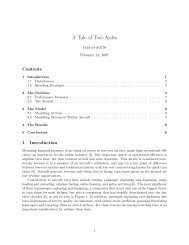Neural Models of Bayesian Belief Propagation Rajesh ... - Washington
Neural Models of Bayesian Belief Propagation Rajesh ... - Washington
Neural Models of Bayesian Belief Propagation Rajesh ... - Washington
You also want an ePaper? Increase the reach of your titles
YUMPU automatically turns print PDFs into web optimized ePapers that Google loves.
240 11 <strong>Neural</strong> <strong>Models</strong> <strong>of</strong> <strong>Bayesian</strong> <strong>Belief</strong> <strong>Propagation</strong> <strong>Rajesh</strong> P. N. Rao<br />
each feature-location (L, F ) combination to the closest Ci using an appropriate<br />
distribution P (Ci|L, F ) (see section 11.4 for an example). An image with a specific<br />
feature at a specific location is generated according to the image likelihood<br />
P (I|C).<br />
Given the above graphical model for images, we are interested in computing<br />
the posterior probabilities <strong>of</strong> features (more generally, objects or object parts)<br />
and their locations in an input image. This can be done using belief propagation.<br />
Given the model in figure 11.3A and a specific input image I = I ′ ,<br />
belief propagation prescribes that the following ?messages? (probabilities) be<br />
transmitted from one node to another, as given by the arrows in the subscripts:<br />
mL→C = P (L) (11.8)<br />
mF →C = P (F ) (11.9)<br />
mI→C = P (I = I ′ |C) (11.10)<br />
mC→L = <br />
P (C|L, F )P (F )P (I = I ′ |C) (11.11)<br />
F<br />
C<br />
mC→F = <br />
P (C|L, F )P (L)P (I = I ′ |C) (11.12)<br />
L<br />
C<br />
The first three messages above are simply prior probabilities encoding beliefs<br />
about locations and features before a sensory input becomes available. The<br />
posterior probabilities <strong>of</strong> the unknown variables C, L, and F given the input<br />
image I, are calculated by combining the messages at each node as follows:<br />
P (C|I = I ′ <br />
) = αmI→C P (C|L, F )mL→CmF →C<br />
(11.13)<br />
F<br />
L<br />
P (L|I = I ′ ) = βmC→LP (L) (11.14)<br />
P (F |I = I ′ ) = γmC→F P (F ), (11.15)<br />
where α, β, and γ are normalization constants that make each <strong>of</strong> the above<br />
probabilities sum to 1. Note how the prior P (L) multiplicatively modulates<br />
the posterior probability <strong>of</strong> a feature in equation 11.15 via equation 11.12. This<br />
observation plays an important role in section 11.4 below where we simulate<br />
spatial attention by increasing P (L) for a desired location.<br />
11.3 <strong>Neural</strong> Implementations <strong>of</strong> <strong>Belief</strong> <strong>Propagation</strong><br />
11.3.1 Approximate Inference in Linear Recurrent Networks<br />
We begin by considering a commonly used neural architecture for modeling<br />
cortical response properties, namely, a linear recurrent network with firingrate<br />
dynamics (see, for example, [5]). Let I denote the vector <strong>of</strong> input firing<br />
rates to the network and let v represent the output firing rates <strong>of</strong> N recurrently<br />
connected neurons in the network. Let W represent the feedforward synaptic<br />
weight matrix and M the recurrent weight matrix. The following equation
















